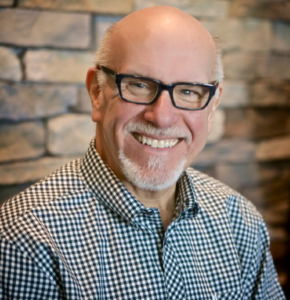 This month’s PB creator interview is with Rob Sanders, a native of Springfield, Missouri. He is a picture book author, a language arts teacher, and a coach for other picture book writers. He worked for fifteen years in religious educational publishing as a writer, editor, editorial manager, and product designer.
This month’s PB creator interview is with Rob Sanders, a native of Springfield, Missouri. He is a picture book author, a language arts teacher, and a coach for other picture book writers. He worked for fifteen years in religious educational publishing as a writer, editor, editorial manager, and product designer.
His picture books include: Cowboy Christmas (Golden Books/Random House), Outer Space Bedtime Race (Random House Children’s Books) named one of the top 20 rhyming picture books of 2015 by KidLit TV and winner of the SCBWI Crystal Kite Award, Ruby Rose—Off to School She Goes (HarperCollins), Rodzilla (Margaret K. McElderry Books/Simon & Schuster) which just won the Gold Medal for Younger Children’s Literature in the Florida Book Awards, and Ruby Rose Big Bravos (HarperCollins).
This year, Rob will release his first nonfiction picture books. In April comes Pride: The Story of Harvey Milk and the Rainbow Flag (Random House Children’s Books) and in the fall Peaceful Fights for Equal Rights will release from Simon & Schuster. 2019 releases include Stonewall: A Building. An Uprising. A Revolution. (Random House Children’s Books) and Ball and Balloon (Simon & Schuster).
Rob Sanders is represented by Rubin Pfeffer.
Website: robsanderswrites.com
Blog: robsanderswrites.blogspot.com
Email: rob@robsanderswrites.com
Facebook: www.facebook.com/RobSandersWrites
Twitter: Twitter.com/RobSandersWrite
RVC: Your PB career launched with a series of fiction books (Cowboy Christmas, and the Ruby Rose series), then you got into nonfiction PB with Pride, Stonewall, and Peaceful Fights for Equal Rights. In what way is your writing process different for writing fiction vs. nonfiction?
RS: There are more similarities between writing fiction and nonfiction than there are differences. Both require a fresh, unique idea. Or a new take on an existing idea. Both demand a compelling/intriguing/turn-the-page story line. And both must be written concisely with stellar word choices, figurative language, and rich vocabulary. Beyond that—and that’s a lot to get beyond—the differences become apparent.
Of course, nonfiction has research at its core. I’ve gone about my research differently for each of my soon-to-be published nonfiction picture books. Pride: The Story of Harvey Milk and the Rainbow Flag was written out of raw emotion. I completed the first draft the night of the SCOTUS decision for marriage equality. I did all my research after writing the first draft. I don’t recommend that approach on an ongoing basis, but this was a heart book and that’s how it happened. Stonewall: A Building. An Uprising. A Revolution. was totally different. For that book, I researched until my head spun—I knew the weather on the day of the event, knew there was a full moon, researched the composition of the streets, and since the story takes place over the 100+ year history of the buildings that make up the Stonewall Inn, I learned from land surveys, historic building designations, photographs, and more about the buildings at various stages of their existence. Then I tried to find a way into the story, landing eventually on the idea of writing from the perspective of the buildings.
Peaceful Fights for Equal Rights was researched heavily, too. My goal was to discuss the various nonviolent protests from the 60s until today. Once I had my stack of research, I threw it all away and made a rhythmic, melodic listing of the types of protests I’d learned about.
Another component of nonfiction is back matter—and I’ve discovered I love writing back matter, including timelines, mini bios, book lists, glossaries, and more. Bottom line, the difference between fiction and nonfiction writing is research. (I guess I could have saved you a lot of time and just given that statement!)
RVC: Like plenty of other PB writers, your day job is teaching in an elementary classroom. How does that inform your PB career?
RS: Teaching in an elementary classroom was the final push I needed to pursue my writing dreams. My students encouraged me (or guilt-tripped me) by continually asking, “Where are your books, Mr. Sanders?” On a daily basis, I see what’s interesting to my students and what isn’t, what topic I want to cover and can’t find a book for, and hear kids say things that give me ideas. Last year, a kindergartner coming out of the Media Center dropped her books and in exasperation said, “I hate gravity.” That inspired my book Ball and Balloon which comes out from Simon & Schuster in 2019.
My students love to see my books at various stages of production. They like seeing that editors edit my work (“Turnabout’s fair play, right, Mr. Sanders?”), and they’re intrigued by books in the sketch stages. Their excitement builds when I show them folded and gathered pages (F&Gs) of a new book. And then a new book finally arrives.
This week I displayed Pride in my classroom but told my students we couldn’t read it until the official release day. (I call it Book Torture.) Come release day we’ll have a birthday party for my new book, we’ll read the book together and make it check-out-able, and we’ll celebrate together. My students are also a bit of a focus group for me. I try out story ideas on them, read an early draft, or ask them questions. But kids can be brutally honest. So, if you’re looking for someone to pat you on the head and say, “You’re such a good writer,” you’d better look elsewhere.
RVC: Do you have a formal writing group beyond your class of fourth graders? How important is it for a PB writer to have a workshop group to run manuscripts past?
RS: Thanks for recognizing my fourth graders as a formal writing group. They take their writing seriously and are learning to critique one another’s work using the hamburger method—a positive comment, constructive feedback, and concluding with another positive comment. Every writer needs feedback no matter how seasoned he/she might be.
My first two steps on my writing journey nine years ago were to join the Society of Children’s Book Writer and Illustrators (SCBWI—visit them at scbwi.org) and to join a critique group. The first group I found was a mixed children’s genre group. It was helpful, but no one else in the group wrote picture books and the members weren’t able to give me much constructive feedback. So, I started my own group. I put a notice out through SCBWI, found some interested folks, and we started meeting monthly. At various time I’ve juggled two or three critique groups at a time—some online. Now I have one critique group with four other writers. We meet twice a month for a couple of hours to read and critique one another’s work and to encourage one another.
I recently was at the Eric Carle Museum of Picture Book Art to celebrate the release of Jane Yolen’s 365th book. Jane introduced her critique group that has met together for over 40 years. Members have come and gone, but the core group is still there. Two of the members stand out to me—Leslea Newman and Patricia MacLachlan. If they need a critique group, so do I.
Whether you’re a 4th grader or have just released your 365th book, you need a tribe, honest feedback, encouragement, and someone who will occasionally give you a good kick in the rear to get you moving.
RVC: As opposed to many other PB makers—like, say, Peter Brown, who maintains a fairly steady pace of about 1 book per year—you’re becoming quite prolific. Witness Pride being published this month and three more of your titles hitting the shelves in the next 15 months! How many different PB projects are you working on at any one point? And how do you manage the day-to-day logistics of the researching, writing, and revision, especially when you’ve got such an important day job?
RS: I’m crazy busy, I can tell you that. At any given time, I’ll be working on anywhere from five to ten picture book projects in various stages, and I’ll have tons of other ideas brewing. Right now, my agent has three nonfiction picture books making the rounds and a couple of fiction books. I just sent off two poems to Cricket because I’m hoping to break into that market. I’m also working on a historical fiction middle grade novel in verse. Bottom line—I keep plugging away.
I don’t have a regular schedule. I write as I find moments of time, often in the in-between moments of my full-time job. Weekends are productive times for me, as are evenings, and any break from school. I jot down notes all the time and dictating ideas into my phone is my latest obsession. I’ll squeeze in some research during my lunch hour or stay in my classroom after the end of the work day to work on a revision, a critique, to conduct an interview, or to respond to emails from an editor.
If you love something, you find the time. If you’re committed to something you go after it until you think you should be committed!
RVC: What are some of the key changes you’ve seen in the PB industry over the years?
RS: The most obvious change I’ve seen in the picture book industry is shorter and shorter texts. When I started writing nine years ago, we frequently heard in conferences that a perfect length for a picture book was 1000 words. That quickly became 800, then 500 words. Now picture books are even shorter and more compressed. I believe that’s because the focus age for picture books is getting younger and younger, and older picture book readers are being pushed into early readers, beginning chapter books, and so on earlier and earlier. Some of that shift might be a financial issue for book buyers. It’s certainly less expensive to buy an earlier reader than a picture book.
The other big change in the picture book industry is the renewed interest in nonfiction. Common Core (and other new state standards) are at the center of that change. Kids in elementary schools are supposed to have a 50/50 split in what they read—50% fiction and 50% nonfiction. Kids are loving nonfiction, and I’m loving the unique and special nonfiction books that are making their way through publishing houses and out into the world.
RVC: What’s one change you’d like to see happen in the PB industry?
RS: I love when editors make their likes and dislikes known. Their preferences. That helps me know if my writing is a fit for that editor or not, and, if it is a fit, the information guides me to know which of my projects might be a perfect match for that editor.
When editors give guidelines to writers I wish they would say something like: in my opinion, for me, I prefer, and so on. Often writers end up thinking there’s a long list of industry rules, when in fact what they heard was one person’s thinking. There are no rules, really.
Finally, I wish that there was more diversity in picture book publishing at the publishing house level. If we want real diversity in books (and we’re making progress in that area), it starts at the top.
RVC: Knowing what you know now, what advice would you give to your beginning PB writer self?
RS: Have faith.
Don’t give up.
It works if you work it.
Persevere.
Press on.
Don’t try to be like anyone else.
Trust yourself.
Find your voice.
Write from your heart.
RVC: Thanks so much, Rob!





